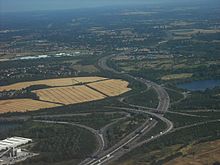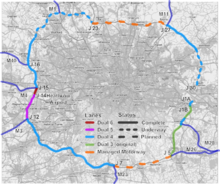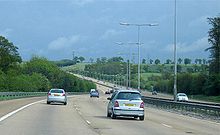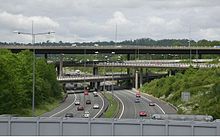
M25 motorway
About this schools Wikipedia selection
Arranging a Wikipedia selection for schools in the developing world without internet was an initiative by SOS Children. Do you want to know about sponsoring? See www.sponsorachild.org.uk
| M25 motorway | |
|---|---|
 M25 is highlighted in dark blue. |
|
| Route information | |
| Part of |
|
| Length: | 117 mi (188 km) |
| Existed: | 1975 – present |
| History: | Completed 1975–86 |
| Major junctions | |
| Orbital around London | |
|
J12 → M3 motorway Junction 2 J15 → M4 motorway Junction 4b J16 → M40 motorway Junction 1a J21 → M1 motorway Junction 6a J23 → A1(M) motorway Junction 1 J27 → M11 motorway Junction 6 |
|
| Location | |
| Primary destinations: |
London, Dartford, Sevenoaks, Reigate, Staines, Heathrow Airport |
| Road network | |
|
|
The M25 motorway or London Orbital motorway is a 117-mile (188 km) motorway that (almost) encircles Greater London, England, in the United Kingdom. The motorway was first mooted early in the 20th century as part of the plan to build four ring roads around London. A few sections, based on the abandoned London Ringways plan, were constructed in the early 1970s and it was completed in 1986. At 117 miles (188 km) (including the A282), the M25 is Europe's second longest orbital road after the Berliner Ring, which is 122 miles (196 km) long.
It is one of the busiest and most congested parts of the British motorway network: 196,000 vehicles were recorded in a single day near London Heathrow Airport. Plans to widen additional sections to eight lanes (four each way) were scaled back in 2009 in response to rising costs.
Description
Originally built mainly as a dual three-lane motorway, much of the motorway has subsequently been widened to dual four-lanes in places and to a dual five-lane section between junctions 12 and 14 and a dual six-lane between junctions 14 and 15. Further widening is in progress with plans for managed motorways on other sections.
The M25 is not a continuous loop. To the east of London, the Dartford Crossing of the Thames between Thurrock and Dartford has the non-motorway classification A282; the Crossing, which consists of two tunnels and the QE2 (Queen Elizabeth II) bridge, is named Canterbury Way. Passage across the bridge or through the tunnels is subject to a toll, depending on the kind of vehicle. Making this stretch a motorway would prevent any traffic not permitted to use motorways from crossing the River Thames east of the Woolwich Ferry.
At junction 5 near Sevenoaks, drivers continuing around the M25 in either direction must follow the slip roads. The anticlockwise carriageway continues eastward as the M26 (towards the M20); the clockwise carriageway continues towards the south coast as the A21.
The distance of the motorway from central London (taken as Charing Cross) varies from 12.5 miles (20.1 km) near Potters Bar to 19.5 miles (31.4 km) near Byfleet. In some places (Enfield, Hillingdon and Havering) the Greater London boundary has been realigned to the M25 for minor stretches; while in others, most notably in Essex and Surrey, it is many miles inwards. Major towns such as Epsom, and Watford are within the M25. North Ockendon is the only settlement of Greater London situated outside the M25. In 2004, following an opinion poll, a move was mooted by the London Assembly to align the Greater London boundary with the M25. "Inside the M25" and "outside the M25" or "beyond the M25" are used colloquially to refer to London and the provinces; the Communications Act 2003 explicitly uses the M25 as the boundary in requiring a proportion of television programmes to be made outside the London area.
There are four Motorway service areas on the M25. These are located at South Mimms (to the north of London) Thurrock (to the east), Clacket Lane (to the south-east) and Cobham (to the south-west). Cobham services were opened on 13 September 2012.
Much of the M25 is lit to help reduce accidents. The current illuminated sections are from Dartford to junction 3, junction 5, junctions 6 to 21a and junctions 23 to 31. The type of lighting varies. Some sections use the older yellow low-pressure sodium (SOX) lighting while others use modern high-pressure sodium (SON) lighting. Some stretches have recently been upgraded to SON lighting. These include Junction 5, junctions around Heathrow and Junction 27.
The motorway passes through six counties, as well as some of Greater London. Junctions 1a–5 are in Kent, 6–13 are in Surrey, apart from a small stretch between junctions 12 and 13 which is in Berkshire. Junction 14 is on the Surrey – Greater London border, 15 is on the Buckinghamshire, Berkshire and Greater London border, 16 is in Buckinghamshire, 17–24 are in Hertfordshire, 25 is in Greater London (the Hertfordshire border going around the junction's northern edge), 26–28 in Essex, 29 in Greater London and 30–31 in Essex. Policing of the road is carried out by an integrated policing group made up of the Metropolitan, Thames Valley, Essex, Kent, Hertfordshire and Surrey forces.
The M25 is one of Europe's busiest motorways. In 2003, 196,000 vehicles a day were recorded on the motorway just south of London Heathrow Airport between junctions 13 and 14.
History
Plans and construction


A precursor of the M25 was the North Orbital Road (see A414 road).
The idea of an orbital road around London was first proposed early in the 20th century and then re-examined in Sir Charles Bressey's and Sir Edwin Lutyens' The Highway Development Survey, 1937. Sir Patrick Abercrombie's County of London Plan, 1943 and Greater London Plan, 1944 proposed a series of five roads encircling the capital. The northern sections of the M25 follow a similar route to the World War II Outer London Defence Ring.
Little was done to progress these plans until the 1960s when the Greater London Council developed their London Ringways plan which consisted of four 'rings' around the capital. Sections of the two outer rings – Ringway 3 (the ' M16 motorway') and Ringway 4 were constructed in the early 1970s and these were later integrated into the single M25 orbital motorway. The Ringways plan was however hugely controversial due to the destruction required for the inner two ring roads ( Ringway 1 and Ringway 2). Parts of Ringway 1 were constructed (including West Cross Route and Westway) against stiff opposition before the overall plan was abandoned in 1973 following pressure from residents in the threatened areas.
Construction of parts of the two outer ring roads, Ringways 3 and 4, were however started in 1973. The first section, between South Mimms and Potters Bar in Hertfordshire (junction 23 to junction 24) opened in September 1975 and was given the temporary general purpose road designation A1178; a section south of London (junction 6 to junction 8) opened in 1976. A section of Ringway 3 south of the river between Dartford and Swanley (junction 1 to junction 3) was constructed between 1974 and 1977.
In 1975 the plans for Ringway 3 were modified to combine it with Ringway 4, the outermost Ringway. The combined motorway was given the designation M25 which had originally been intended for the southern and western part of Ringway 4 and the M16 designation was dropped. The section of Ringway 3 west of South Mimms anti-clockwise around London to Swanley in Kent was cancelled. The stages were not constructed contiguously but in small sections. As the orbital road developed the sections were linked. Each section was presented to planning authorities in its own right and was individually justified, with almost 40 public inquiries relating to sections of the route. Maps at this time depicting these short sections named the route as the M16 but this changed before completion.
The section from Potters Bar to the Dartford Tunnel was constructed between 1979 and 1982. Construction of the M25 continued in stages until its completion in 1986. Prime Minister Margaret Thatcher officially opened the M25 on 29 October 1986, with a ceremony in the section between J22 and J23 ( London Colney and South Mimms). The initial tenders for the construction of the M25 totalled £631.9 million. This did not include compulsory purchase of land and subsequent upgrades and repairs.
Operational history
Soon after the motorway opened in 1986 traffic levels exceeded maximum designed capacity and in 1990 the Secretary of State for Transport announced plans to widen the whole of the M25 to four lanes. By 1993 the motorway that was designed for a maximum of 88,000 vehicles per day was carrying 200,000, 15% of UK motorway traffic volume was on the M25 and there were plans to add 6 lanes to the section from Junction 12 to 15 as well widening the rest of the motorway to 4 lanes
In 1995 a contract was awarded to widen the section between junctions 8 and 10 from six to eight lanes for a cost of £93.4 million and a Motorway Incident Detection and Automatic Signalling (MIDAS) system was introduced to the M25 from junction 10 to junction 15 at a cost of £13.5m in 1995 and then extended to junction 16 at a cost of £11.7m in 2002. This consists of a distributed network of traffic and weather sensors, speed cameras and variable-speed signs that control traffic speeds with little human supervision, and has improved traffic flow slightly, and reduced the amount of start-stop driving.
In 1995 there was a proposal to widen the section close to Heathrow Airport to 14 lanes. This attracted fierce opposition from road protesters opposing the Newbury Bypass and other schemes and it was cancelled shortly afterwards. However, in 1997 the Department of Transport announced new proposals to widen the section from junction 12 (M3) and junction 15 (M4) to 12 lanes. At the Terminal Five public inquiry a Highways Agency official said that the widening was needed to accommodate traffic to the proposed new terminal, however the transport minister said that no such evidence had been given. Environmental groups objected to the decision to go ahead a scheme that would create the widest motorways in the UK without holding a public inquiry. The decision was again deferred. A decision to go-ahead was given for a 10-lane scheme in 1998 and the £148 million 'M25 Jct 12 to 15 Widening' contract was awarded to Balfour Beatty in 2003. The scheme was completed in 2005 as dual-five lane between junctions 12 to 14 and dual six lanes from 14 to 15.
In 2007 capacity at junction 25 (A10/Waltham Cross) was increased and the Holmesdale Tunnel was widened to 3 lanes in an eastern direction at a cost of £75 million.
Work to widen the exit slip-roads in both directions at Junction 28 ( A12 road/A1023) was completed in 2008. It was designed to reduce the amount of traffic queueing on the slip roads at busy periods, particularly traffic from the clockwise M25 joining the northbound A12 where the queue can extend onto the inside lane of the Motorway.
Design, Build, Finance and Operate (DBFO) contract
In 2006 the Highways Agency proposed to widen 63 miles (101 km) of M25 from six to eight lanes, between junctions 5–6 and 16–30 as part of a Design, Build, Finance and Operate (DBFO) project. A shortlist of contractors was announced in October 2006 for the project which was expected to cost £4.5 billion. Contractors were asked to resubmit their bids in January 2008 and in June 2009 the new transport minister indicated that the cost had risen to £5.5 billion and the benefit to cost ratio had dropped considerably. In January 2009 the government announced that plans to widen the sections from Junction 5–7 and from 23–27 had been 'scrapped' and that hard shoulder running would be introduced instead.
In 2009 a £6.2 billion M25 'Design, Build, Finance and Operate' (DBFO) private finance initiative contract was awarded to Connect Plus to widen the sections between junctions 16 and 23 and between junctions 27 and 30 and maintain the M25 and the Dartford Crossing for a 30 year period.
Works to widen the section between junctions 16 and 23 (M40-A1(M)) to dual 4 lanes started in July 2009 at an estimated cost of £580m; The J16-21 section (M40 to M1) was completed by July 2011 and from J21-23 (M1 to the A1(M)) by June 2012. Works to widen the J27-30 section (M11-A13) to dual 4 lanes started in July 2009. J27-28 (M11-A12) was completed in July 2010, J28-29 (A12-A127) in June 2011 and J29-30 (A127-A13) in May 2012.
Proposed developments
M25 Jct 5 to 7 managed motorway
The Highways Agency plans to introduce managed motorway with hard shoulder running on the M25 from Junctions 5 to 7 (M26 – M23/Redhill) with work starting in 2012/3.
M25 possible new junction 10a at Byfleet
There are plans for a junction to connect with the A245 to offer quicker access to Woking Town Centre, although the time frame is not given.
M25 Jct 23 to 27 managed motorway
The Highways Agency plans to introduce managed motorway with hard shoulder running on the M25 from Junctions 23 to 27 (A1(M)-M11), with work taking place between early 2013 and February 2015.
Junction 30 improvement
Preparation work to increase capacity at Junction 30 (Thurrock) as part of the Thames Gateway Delivery Plan is underway although there is no guarantee of delivery. Plans were announced in 2007. An early estimate on the start of major works was given as 2013/2014. Philip Hammond has confirmed that there will be no funding for the J30 improvements in this spending period, but has announced that preparation work would continue so that the scheme could be funded at a later date.
Lower Thames Crossing
In 2009 the Department for Transport published options for a new Lower Thames Crossing to add capacity to the Dartford Crossing or create a new road and crossing linking to the M2 and M20 motorways.
Comparisons
Other cities encircled by motorways include Manchester using the M60 motorway, Birmingham using parts of the M5, M6 and M42 and from 2011 Glasgow has an orbital motorway made of the M8, M73 and M74 although one section of the route passes through the centre of the city. The M25 is the second-longest ring road in Europe, after the Berlin Ring ( A 10) which is 5 miles (8.0 km) longer. The M25 is one of the busiest motorways in Europe:
- M25 around London: 196,000 vehicles a day recorded in 2003 between junctions 13 and 14 near London Heathrow Airport.
- A23 (Vienna): More than 200,000 vehicles on an average day.
- A 100 (Berlin): 216,000 vehicles in a day was recorded in 1998
- A4 motorway (near Paris): 257,000 vehicles a day recorded in 2002.
Popular culture
Iain Sinclair's book and film London Orbital, which was published in 2002, is based on a year long journey around the M25 on foot.
The M25 (including the A282 Dartford Crossing) is known for its frequent traffic jams. These have been the subject of so much comment from such an early stage that even at the official opening ceremony Margaret Thatcher complained about "those who carp and criticise". The jams have inspired jokes ("the world's biggest car park", "the London Orbital Car Park") and songs ( Chris Rea's " The Road to Hell").
The M25 plays an important role in the comedy-fantasy novel Good Omens, being "evidence for the hidden hand of Satan in the affairs of Man". The demon character, Crowley, had manipulated the design of the M25 to resemble a Satanic sigil.
The M25 enjoyed a more positive reputation among ravers in the late 1980s when this new orbital motorway became a popular route to the parties that took place around the outskirts of London. This use of the M25 for these raves inspired the name of electronic duo Orbital.
Racing
The orbital nature of the motorway, in common with racetracks, lent itself to unofficial, and illegal, motor racing. At the end of the 1980s, before the advent of speed enforcement devices, owners of supercars, many employed in the financial service industry in the City and in Docklands, would meet at night at service stations such as South Mimms and conduct time trials. Times below 1 hour were achieved; an average speed of over 117 mph (188 km/h), which included coming to a halt at the Dartford Tunnel road user charge payment booths.
Junctions
Data from driver location signs provide carriageway identifier information. The numbers on the signs are kilometres from a point near the River Thames, east of London, when travelling clockwise on the motorway. The table below gives details of each junction, including the roads interchanged and the destinations that are signed from the motorway. Figures in kilometres are from the driver location signs; figures in miles are derived from them.
| A282 road – Dartford Crossing | |||||
| miles | km | Clockwise exits (A carriageway) | Junction | Anti-clockwise exits (B carriageway) | |
|---|---|---|---|---|---|
| Dartford Crossing A282 Dartford Tunnel |
River | Dartford Crossing A282 Queen Elizabeth Bridge |
|||
| 3.5 | 5.7 | Erith A206 | J1a | Erith A206, Swanscombe ( A226) | |
| 4.7 | 7.5 | Dartford A225 | J1b | Exit via J2 – Dartford ( A225) | |
| M25 motorway – London Orbital | |||||
| 5.5 | 8.8 | London (South East), Canterbury A2, (M2), Bluewater | J2 | London (SE & C), Lewisham A2(W), Canterbury A2(E) ( M2), Dartford (A225) | |
| 8.7 | 14.0 | London (South East) A20 Maidstone M20 Swanley B2173 |
J3 | Maidstone, Channel Tunnel M20 London (SE & C), Lewisham A20 |
|
| 12.2 | 19.6 | Bromley A21 Orpington A224 |
J4 | Bromley, London (SE) A21 Orpington (A224) |
|
| 16.3–16.4 | 26.2–26.4 | Sevenoaks, Royal Tunbridge Wells, Hastings A21 | J5 | Maidstone, Channel Tunnel, Dover M26 (M20) Sevenoaks, Hastings A21 |
|
| 21.0 | 33.8 | Clacket Lane services | Services | Clacket Lane services | |
| 25.8 | 41.6 | East Grinstead, Eastbourne, Caterham, Godstone A22 Westerham ( A25) |
J6 | Eastbourne, Caterham, Godstone A22, Westerham (A25) | |
| 28.6 | 46.0 | Gatwick Airport, Crawley, Brighton, East Grinstead, Croydon M23 | J7 | Gatwick, Brighton, M23(S), Croydon M23(N) | |
| 31.9 | 51.4 | Reigate, Sutton A217 Redhill (A25) |
J8 | Reigate, Sutton A217 Redhill ( A25) |
|
| 38.5 - 39.5 |
62.0 - 63.5 |
Leatherhead A243 Dorking ( A24) |
J9 | Leatherhead A243 Dorking (A24) |
|
| 42.6 - 43.2 |
68.6 - 69.5 |
Cobham Services | Services | Cobham Services | |
| 45.0 | 72.4 | London (South West), Sutton, Guildford, Portsmouth A3 | J10 | London (South West), Guildford, Portsmouth, A3 | |
| 49.8 | 80.2 | Chertsey A317 Woking A320 |
J11 | Woking A320 Chertsey A317 |
|
| 52.1 | 83.8 | Basingstoke, Southampton, Richmond M3 | J12 | Basingstoke, Southampton, Richmond M3 | |
| 55.2 | 88.8 | A30 London (West), Hounslow, Staines | J13 | A30 London (West), Hounslow, Staines | |
| 57.0 | 91.8 | Heathrow Airport (Terminals 4, 5 and Cargo) A3113 dedicated spur | J14 | Heathrow Airport (Terminals 4, 5 and Cargo) A3113 dedicated spur | |
| 59.0 | 95.0 | The West, Slough, Reading, London (West), Heathrow Airport (Terminals 1, 2 and 3) M4 | J15 | The West, Slough, Reading M4(W) London (W), Heathrow (Terminals 1, 2 & 3) M4(E) |
|
| 63.8 | 102.6 | The North, Birmingham, Oxford, Uxbridge, London (W,C) M40 | J16 | Birmingham, Oxford M40(W) Uxbridge, London (W & C) M40(E) |
|
| 68.7 | 110.5 | Maple Cross ( A412) | J17 | Maple Cross A412 | |
| 69.9 | 112.5 | Rickmansworth, Chorleywood, Amersham A404 | J18 | Chorleywood, Amersham, Rickmansworth A404 | |
| Watford A41 | J19 | No exit | |||
| 73.8 | 118.7 | Hemel Hempstead, Aylesbury A41 | J20 | Hemel Hempstead, Aylesbury, Watford A41 | |
| 76.3 | 122.8 | The North, Luton & Airport M1 | J21 | The North, Luton & Airport M1 | |
| 76.9 | 123.7 | Watford A405 Harrow (M1 South) |
J21A | St Albans A405 London (North West) (M1 (South)) |
|
| 80.6 | 129.7 | London Colney A1081 | J22 | St Albans A1081 | |
| 83.3 | 134.0 | Hatfield A1(M) London (North West) A1 Barnet A1081 South Mimms services |
J23 Services |
Hatfield A1(M), London (NW) A1 Barnet A1081, Services |
|
| 85.9 | 138.2 | Potters Bar A111 | J24 | Potters Bar A111 | |
| 91.4 | 147.1 | Enfield Town, Hertford A10 | J25 | Enfield, Hertford, London (N & C) A10 | |
| 94.9 | 152.7 | Waltham Abbey, Loughton A121 | J26 | Waltham Abbey, Loughton A121 | |
| 99.2 | 159.7 | London (NE), Stansted Airport, Harlow, Cambridge M11 | J27 | London (NE & C) M11(N), Stansted, Harlow, Cambridge M11(S) | |
| 107.1 | 172.4 | Chelmsford, Witham, Colchester A12 Brentwood A1023 |
J28 | Chelmsford, Romford A12 Brentwood A1023 |
|
| 109.9 | 176.8 | Romford, Basildon, Southend A127 | J29 | Basildon, Southend, Romford A127 | |
| 115.2 | 185.4 | Dagenham, Rainham, Tilbury, Barking, London (E & C) A13 Thurrock services |
J30 | Dagenham, Rainham, Tilbury, Basildon, London (E & C) A13, West Thurrock (A126) | |
| A282 Road – Dartford Crossing | |||||
| 115.9 | 186.6 | Access via J30 | J31 Services |
Thurrock ( Lakeside), Services A1306, Purfleet ( A1090), West Thurrock ( A126) | |
| Dartford Crossing A282 Dartford Tunnel |
River | Dartford Crossing A282 Queen Elizabeth Bridge |
|||
Notes
|
|||||
|
|||||
Anti-clockwise information above gathered from Advanced Direction Signs August 2011 (J9 – J22, J20 – J15)








